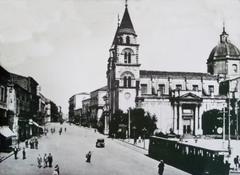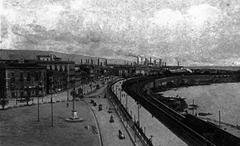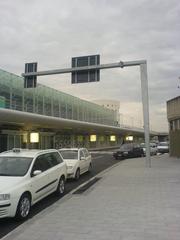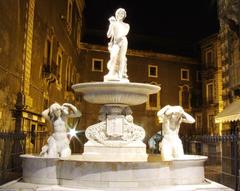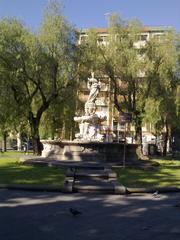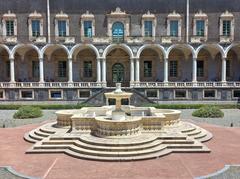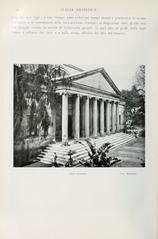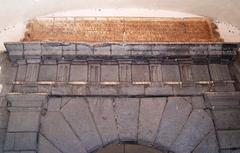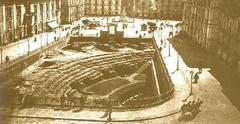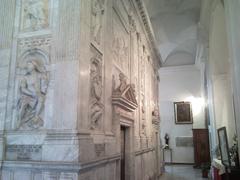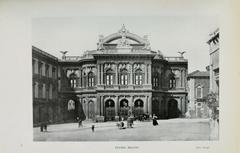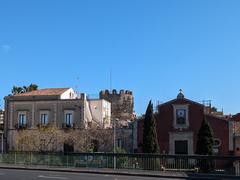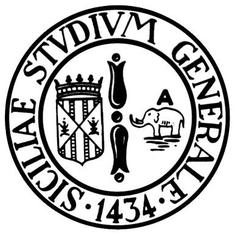Basilica della Collegiata Catania: Visiting Hours, Tickets, and Historical Sites Guide
Date: 15/06/2025
Introduction
Nestled along Catania’s vibrant Via Etnea, the Basilica della Collegiata (Basilica Maria Santissima dell’Elemosina) stands as a crowning achievement of Sicilian Baroque architecture and a living testament to the city’s layered religious and cultural history. Originally built atop a pagan temple dedicated to Proserpina, the site evolved into a Christian sanctuary and, following the catastrophic 1693 earthquake, was magnificently rebuilt by architects Angelo Italia and Stefano Ittar. Today, the basilica functions both as an active place of worship and a showcase of Catania’s resilience, artistry, and devotion.
This comprehensive guide covers the basilica’s historical evolution, architectural highlights, visitor information, travel tips, and its significance within Catania’s Baroque heritage (Sicilian Blog, 2019, Comune di Catania Official Tourism, Livetheworld, Around Catania). Whether you are a history enthusiast, architecture lover, or spiritual pilgrim, this guide will help you make the most of your visit to one of Catania’s most cherished landmarks.
Table of Contents
- Introduction
- Early Origins and Historical Development
- The 1693 Earthquake and Baroque Rebirth
- Architectural Features and Artistic Heritage
- Religious and Cultural Significance
- Practical Visitor Information
- Frequently Asked Questions (FAQ)
- Conclusion
- References
Early Origins and Historical Development
The Basilica della Collegiata’s origins trace back to a pagan temple dedicated to Proserpina, the Roman goddess of the underworld and spring. As Christianity spread through Sicily, the temple was replaced by a church honoring the Virgin Mary, embodying the Madonna dell’Elemosina (Our Lady of Charity). By the Byzantine era, Marian devotion was firmly established at the site, and the church gained prominence under Aragonese rule, acquiring the title “Regia Cappella” in 1396—a testament to royal patronage.
In 1446, Pope Eugene IV elevated the church to a collegiate status by instituting a college of canons, enhancing its liturgical and administrative standing in Catania (livetheworld.com).
The 1693 Earthquake and Baroque Rebirth
The devastating earthquake of 1693 destroyed much of Catania, including the original church. The city’s ambitious urban renewal saw the basilica reconstructed as a centerpiece of the Baroque cityscape. Jesuit architect Angelo Italia repositioned the basilica’s façade toward Via Etnea, integrating it into the city’s new rational layout. Later, Stefano Ittar completed the façade, adding refined Baroque elements and the bell tower that define the basilica’s present appearance (SiciliaReport.it).
Architectural Features and Artistic Heritage
Exterior
The façade is a prime example of late Sicilian Baroque, with two tiers of stone columns, a grand staircase, wrought iron gates, and statues of saints including St. Peter, St. Paul, St. Agatha, and St. Apollonia. The upper loggia features an eagle with a crowned coat of arms and a globe surmounted by a cross, symbolizing Christ’s universal sovereignty and imperial legacy (Around Catania).
Interior
Inside, the basilica follows a Latin cross plan with a barrel-vaulted nave, richly decorated with stucco and frescoes. The main altar displays the revered icon of the Madonna dell’Elemosina, a copy of an original Byzantine work from Biancavilla. Frescoes by Giuseppe Sciuti (1896) depict Marian scenes, while the wooden organ and choir stalls reflect the basilica’s musical tradition. Side chapels are dedicated to various saints, with altars adorned in polychrome marble and intricate religious art (Riprendiamoci Catania).
Religious and Cultural Significance
The basilica has long been a focal point of Marian devotion, especially through veneration of the Madonna dell’Elemosina icon. Its collegiate status has fostered a tradition of sacred music and liturgical excellence. The basilica remains at the heart of civic and religious life in Catania, hosting royal visits, local festivals (notably the Feast of St. Agatha), and major religious processions. In 1946, Pope Pius XII conferred the title of minor basilica on the church, underscoring its spiritual and historical importance.
Practical Visitor Information
Visiting Hours
- Monday–Saturday: 8:00 AM – 12:00 PM, 4:00 PM – 7:00 PM
- Sunday: 10:00 AM – 1:00 PM
- Hours may vary on religious holidays or during special events; check on-site or via local tourism sources for updates (Around Catania).
Tickets and Admission
- Entry: Free of charge; donations are welcomed to support maintenance and restoration.
Accessibility
- Wheelchair Accessible: Street-level entrance and minimal internal steps. Ramps and assistance are available upon request.
Guided Tours
- Availability: Local tour operators offer walking tours that include the basilica. Booking in advance is recommended for guided experiences.
- Languages: Some tours available in English; check with operators for details.
Nearby Attractions
- Duomo di Catania: The city’s main cathedral is a short walk away.
- Palazzo degli Elefanti: The historic city hall in Piazza Duomo.
- Teatro Massimo Bellini: Catania’s renowned opera house.
- Monastero di San Benedetto: Another Baroque highlight of the city.
Visitor Tips
- Dress Code: Modest attire is required; cover shoulders and knees.
- Photography: Allowed without flash; restrictions may apply during services.
- Best Times to Visit: Weekday mornings or early afternoons for a quieter experience; during festivals for a vibrant atmosphere.
- Amenities: Numerous cafés, shops, and restaurants are located nearby on Via Etnea.
Frequently Asked Questions (FAQ)
Q: What are the Basilica della Collegiata visiting hours?
A: Monday–Saturday 8:00 AM–12:00 PM and 4:00 PM–7:00 PM; Sunday 10:00 AM–1:00 PM. Hours may vary during holidays.
Q: Is there an entrance fee?
A: No. Entry is free; donations are encouraged.
Q: Are guided tours available?
A: Yes. Local operators and some city tours include the basilica; book in advance for availability.
Q: Is the basilica wheelchair accessible?
A: Yes, with ramps and minimal steps. Contact staff for assistance if needed.
Q: Can I take photographs inside?
A: Photography is generally permitted without flash. Be respectful during services.
Q: What else can I visit nearby?
A: Catania Cathedral, Palazzo degli Elefanti, Teatro Massimo Bellini, Monastero di San Benedetto, and the lively fish market.
Conclusion
The Basilica della Collegiata stands as a beacon of Catania’s Baroque brilliance and spiritual heritage. Its ornate architecture, treasured artworks, and historic significance make it an unmissable destination for anyone exploring the city. With free access, central location, and welcoming atmosphere, the basilica invites visitors to experience the depth of Sicilian culture and faith. Plan your visit using this guide, check the latest updates through the Audiala app or official tourism websites, and immerse yourself in the unique charm of Catania’s historical heart.
References
- Sicilian Blog, 2019, Collegiata Basilica
- Comune di Catania Official Tourism Website
- Livetheworld, Basilica Collegiata S. Maria dell’Elemosina, Catania
- Around Catania, Basilica della Collegiata
- SiciliaReport.it, Le Chiese di Catania: Basilica Maria Santissima dell’Elemosina
- Riprendiamoci Catania, Basilica Maria Santissima dell’Elemosina
